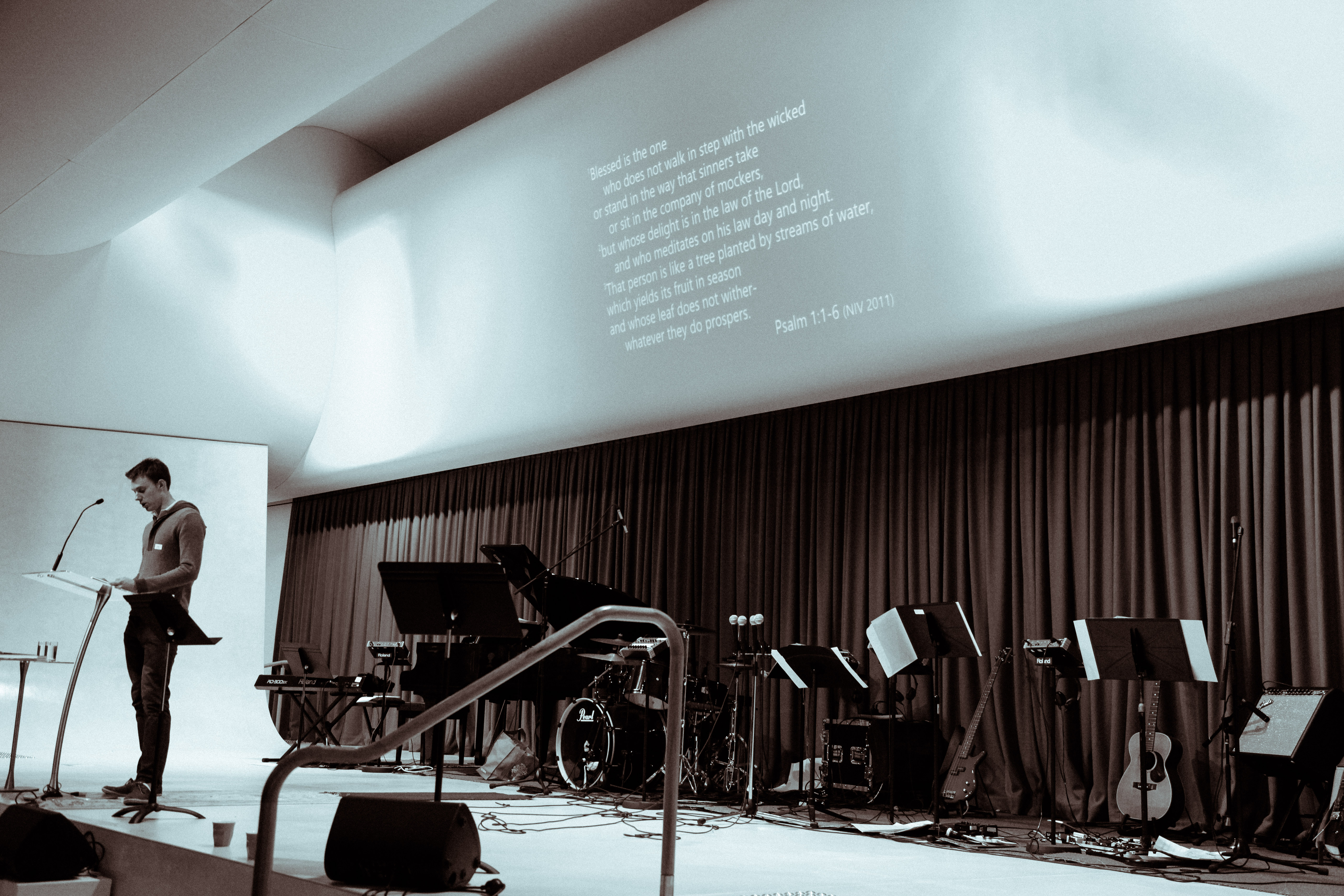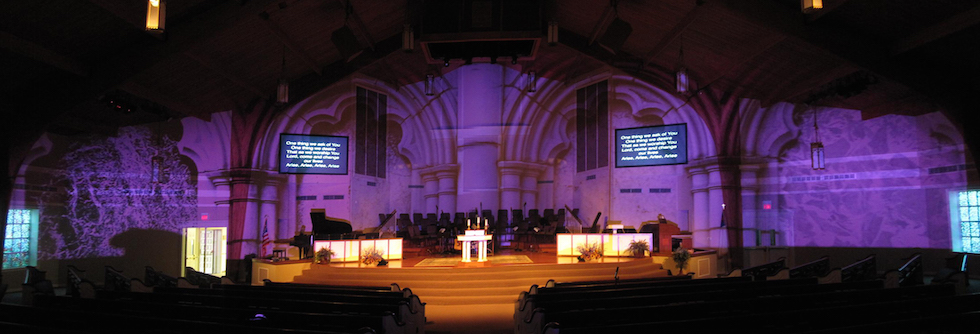Presentations are usually an integral part of the modern church service. Song lyrics, bible verses, liturgy or videos displayed on a projection screen form the basis for many aspects of the service. However, behind the scenes this is often a nightmare to manage. What presentation software do you use? How can you ensure the right content will be on the screen/s at the right time? How do you train people to use it? How do you manage the processes required to collate all the material together? What happens when a guest speaker or presenter turns up last minute with a presentation on a USB Stick (or CD, DVD…)?

But the questions don’t just stop with the technology. The purpose behind presentations is to visually communicate ideas. What does it mean to communicate ideas well? How do you communicate effectively? How do you ensure the technology doesn’t get in the way of the communication, or the other way around?
This article is in 2 parts. Part 1 outlines some guiding principles or factors that are relevant when thinking about doing presentations well. Part 2 looks at various presentation software available and provides analyses on each with respect to these guiding principles.
Content
A big factor in working out how to do presentations well will be what kind of content you are planning to use. There is a big difference between putting up text, such as song lyrics, and putting up images or videos. The content you are planning to put up will affect a number of different areas. For instance, putting up videos these days will likely require a 16:9 aspect ratio for your projectors/screens, resulting in the requirement for all your other content to conform to this aspect ratio.
Deciding on what content you will be using, being aware that you may choose to add in additional content in the future, is an important discussion to be had, as it will affect the technological requirements as well as processes you need to implement. Putting up text only presentations is a lot easier than presentations involving multiple content types and therefore requires less technology, infrastructure and administration.

Style and Design
Regardless of what content type you are going to be using, the style and design of the content is a huge factor in its engagement. From text to images to video, there are a large number of variable that can and should be controlled.
What font are you going to use for the text? How big does it need to be on the screen in order to be readable? How much text on the screen is too much text? What is the resolution size requirement for the images? How many different elements are you going to allow on one slide?
There are many questions to be answered, and many of them don’t have a ‘right’ answer. However, not making a decision and allowing content in any style to go into the presentations is the wrong answer. It is essential to make a style about font choice, colour schemes, image style and resolutions etc. and then to stick to your style guide. You can always change your mind later if the style isn’t working, but allowing content in any style to any style is so much worse than conforming to a style that doesn’t quite work.
Despite there not being many ‘right’ answers, we do have a few tips on style and design that are good general rule:
- Don’t have more than 4 or 5 lines of song lyrics
- Use the bold typeface rather than a bigger font size to help make text more readable
- Bible passages can get away with more text on the screen, but not so much that the screen looks crowded
- Find a natural pause in the song lyric or Bible Passage for the slide break. For Bible Passages, this will be at the end of a sentance or paragraph
- Centre Align song lyrics
- Bible Passages or other text should be left aligned
- Ensure to have no more than 1 image on the screen at a time
- Images should fill the screen as much as possible. Small images are very hard to see
- Stretching an image beyond its original size will make it blurry and pixelated, so ensure the original image has a high enough resolution
- Maximise colour contrast wherever possible, particularly in situations where there is high ambient light. For instance, black text on a white background has a much higher contrast than yellow text on a white background
- In most cases it is a good idea to have a black background for everything (with white text). This is particularly helpful when the projection surface doesn’t have a border (isn’t on a screen) or doesn’t quite fit within the borders.

Ease of use
The software, technology and processes you implement should be easy to use for both operators and administrators. Putting together a presentation every week can be tedious, so any way you can make your administrator’s life easier will be very appreciated (not to mention result in less time spent compiling the presentation). Operating the presentation for a church service can often be stressful, so taking every opportunity to make it easier is incredibly important.
Ease of use is also important for training. Volunteering at church often can be quite transient, with people jumping in and out of various ministries all the time. If the training process for using the presentation software and technology is too complex you will find you stop getting volunteers.
Different Content on different screens
In many situations there will only be a single screen, or multiple screens that will show the same content. However, there will be many setups that at some stage will require different content on multiple screens. For instance, a video foldback screen for the singers and preacher may require the addition of content such as a timer, messaging or speaker notes. An awareness that this may be needed, now or at some point in the future, will dictate the choice of software as well as the infrastructure and technology. Adding in a screen with different content is often quite a step up in complexity with regard to the video system, so it is essential that the appropriate plans are outlined.
Processes
File Management
Keeping files up to date and in good order can be a hassle. However, ensuring that the latest version of a file, image or song lyric is readily available is important. It will be essential to maintain a good process for managing and tracking any new files or changes to old files. The software you use should make this as easy as possible.
Each week’s presentation will likely have to be compiled during the week, so it is also essential to ensure it is easy to gather and compile the relevant files such as song lyrics.
Backup
It is important to create backup plans for when things go wrong, which is always a possibility with technology. What happens if the computer crashes during the service? What happens if someone accidentally deletes today’s file or playlist? What happens to your song lyric database if the hard drive fails? Having a plan for these eventualities will put you in good stead if they do happen. For example, have the presentation file on a USB stick ready to go in case someone accidentally deletes the file off the main computer. It may also be a good idea to back up your song lyric database onto another computer, an external hard drive or into the cloud.
Compilation
Work out a process for how the presentation gets made and compiled. Does the administrator do it, or the senior minister? What happens when they are on holidays? When do they do it? I highly recommend implementing a deadline for content. If the preacher wants slides to go with their sermon, they have to provide them by thursday night. Same for any slides to go with mission spots or otherwise. This will ensure content can be properly vetted for style guide purposes, as well as reduce the possibility of the operator getting inundated with content changes 5 minutes before the service.
Stay tuned for part 2, which will review several common church presentation software packages with reference to the guidelines in this article.
